Pilot actions snapshots per country
LP PROVINCE OF TREVISO – ITALY
DO IT BETTER, DO IT TOGETHER!

The pilot actions are based on the introduction of the concept of Behavioural and analytical demand-side management (DSM). Behavioural DSM focuses on educating consumers and encouraging individual participation to attain energy saving, whereas analytical DSM finds opportunities for saving energy through equipment monitoring and data analytics. PA1 wanted to trigger this process of change or, better yet, for change, by focusing on all users who live and manage buildings, giving them an instant measure of the effectiveness/ineffectiveness of activities undertaken. The first activity to stimulate awareness is visualization; for this reason, immediate and objective evaluation is provided, in the case of Project TOGETHER, by investments in devices for the real-time detection and monitoring of electrical and heat consumption. Two modes of system interventions were carried out and are detailed in the Investment fact-sheet, available on the website. The pilots have been concretely involved in a project of technological and behavioural experimentation. While technological experimentation consists in the installation of devices, as well as in the relevant training and the increased ability to analyze consumption scenarios, behavioural experimentation comprises a series of activities common to all the buildings and for specific activities defined by the single Negotiating Panel. The process can be summarized as follows:
1. Establishment of a mixed work group, composed of as many subjects as represent the building and sub categories of users, called the Negotiating Panel; 2. Implementation of a SWOT survey of issues concerning buildings realized by the working group; 3. implementation of energy audits that suggest a list of necessary interventions to improve energy efficiency in each building; 4. Verification and analysis by the working group of the results of energy audits; 5. Acquisition of skills and knowledge to leverage the potential of sensors; 6. Identification of critical points and definition of an Action plan per pilot building, including technical, financial and Demand Side Management activities; 7. Verification and monitoring of the energy curves and consumption targets; 8. Approval of a building alliance stating a goal of energy reduction to be achieved within a certain testing period. The specific activities of each institute reflect the contents of the intervention plan defined by each negotiating panel on the basis of a framework of suggested interventions, to include “nudges” through the process of training, animation and support triggered by the TOGETHER team. Social investments chosen and conceived by the members of the various Negotiating Panel range from the establishment of an Energy Team to the production of posters/leaflets, as well as the production of videos and signage and the organization of internal awareness events, which, just like “gentle pushes” do, activate processes of reflection and behaviour change. TARGET GROUPS 1. staff working in the 2 institutional buildings involved in the project for a total of 80 persons; 2. end-users of the public buildings actively involved in the project: 300 students, 40 teachers, 20 auxiliary staff; 3. Approximately 5,000 students, staff, teachers and visitors targeted by the peer to peer activities and communication campaign organised in the single pilot buildings and targeted by the info point installed at the premises of the pilot buildings RESULTS 20 tested action plans oriented to integrate demand side management tools with the use of advanced tools to monitor energy consumption; 1 user oriented dashboard dialoguing with the end users; 20 Negotiating panels. It a is a group of people on a specific object/building who work together in a joint effort to reach the set goals of energy saving, thereby achieving mutual benefit; 17 signed Building Alliances out of 20 buildings: the effort to reduce energy consumption is a shared effort; 1 Energy Performance Integrated Contract launched in October 2018 capitalising the experience and data acquired thanks to the implementation of the pilot actions, pros and cons. The contract is published in the Official Gazzette of the Italian Republic and represents the condition for continuing the supporting activities with regard to the 10 Associated partners involved in the project.
PP2 ENERGY AGENCY VYSOČINY - CZECH REPUBLIC
Energy efficiency entails a cultural change!
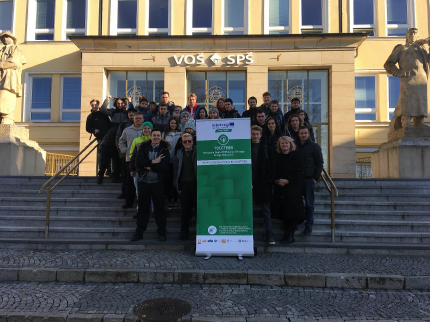
Local activities in Czech pilot clusters were based on energy efficient activities in educational buildings. Due to fact that Czech associated partner – Vysočina Region owns all high school in region and due to fact that work with students is much better then with adult as they are more open to new ideas and approaches, EAV as a project partner decided to work with students of high schools and gymnasiums. During implementation of our pilots students were not the only target group, we have focused on. We worked with different employees of school buildings:
- We had many meetings with school principals who shared their issues and problems in relation to the building and thanks to our direct contact with owner of buildings (associated partner of the project) we could interpret these issues right to the owner. i.e. necessity of energy retrofitting of the building
- Our cooperation with school caretakers were very close too. Due to fact that they know their building very well, we needed them during installation of smart metering. We were in touch on daily basis.
- Teachers from pilot schools took TOGETHER study materials and helped us with enforcement of energy efficient habits.
EAV (based on application form) apply an approach of mixed monitoring system (manual and automatic). 5 buildings were equipped by smart metering system (automatic data collection) and 5 buildings use manual data collection – janitors manually collect consumption data on weekly basis. Following energy is monitored in Czech pilot cluster buildings: Electricity, Gas and Heat. The first part of pilot actions was to analyze technical equipment of the building (heating, cooling, lighting, etc.) to make a list of requirements for smart meters installation. These activities were carried out in cooperation with janitors and caretakers. In buildings without SM system the procedure of manual data collection has been arranged. The second part was installation of smart meters itself and start trial operation of smart meters. To verify the consumption data with real data, janitor collect the consumption data manually too. Subsequently EAV started with raising awareness campaign in pilot buildings. In duration of pilot actions students was introduced in energy efficiency issues and gained their knowledge and habits in the field of energy efficiency and waste management. The involvement of pupils was supported by educational stories (mainly the Planet defenders interactive game, which is commonly used in English language as a combination of English language and physics teaching), posters, labels, notice boards etc. Another important action was exchange of experience between students from different pilot schools, where they meet each other. For students of pilot buildings were organised study visits in cooperation with Chamber of Commerce of Vysočina region, which cover costs for these study visits. During implementation of pilot actions EAV used the Energy audit kit (purchased in WPT2) as a practical example for students. They taught how to work with thermocamera, multifunctional meters, laser distance meter, IR thermometer, and clamp multimeter, but we let them work with other meters with which we work on daily basis too – CO2 meter, Humidity meter, Lux meter etc. Pilot implementation approach was different in different schools based on their interest i.e. in Gymnasium there are very enthusiastic students, there is a team of students who worked on EE activities, they worked with all above mentioned devices fulfilling practical exercises. On the other side in schools were students work with heavy machines and not spend much time in classrooms the approach must be more systematic (i.e. checking of turning off machines which are not used in current time), students and sometimes even teachers are not open to practical examples and exercises, they just "fulfil their duties".
PP3 UNIVERSITY OF MARIBOR – SLOVENIA
Energy Efficiency… a life long learning process!
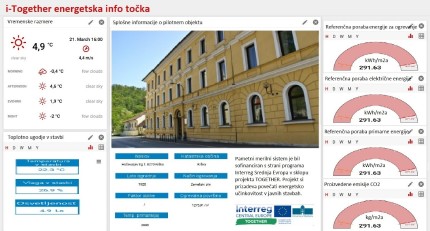
The pilot actions are based on the introduction of the concept of Behavioural and analytical demand-side management (DSM). Behavioural DSM focuses on educating consumers and encouraging individual participation to attain energy saving, whereas analytical DSM finds opportunities for saving energy through equipment monitoring and data analytics. PA3 wanted to trigger the process of change or, better still, for change, by focusing on all users who live and manage buildings, giving them an instant measure of the effectiveness/ineffectiveness of activities undertaken. The first activity to stimulate awareness is, therefore, visualization and immediate and objective evaluation provided, in the case of TOGETHER project, by investments in devices for the real-time detection and monitoring of electricity and heat consumption. Two modes of system interventions were carried out and are detailed in the Investment fact-sheet, available on the website. The pilots have been concretely involved in a project of technological and behavioural experimentation. While technological experimentation consists of the installation of devices, as well as relevant training and the increased ability to analyse consumption scenarios, behavioural experimentation comprises a series of activities common to all the buildings and for specific activities defied by the single Negotiating Panel. The PAs process was as follows:
1. Constitution of a mixed work group, composed of as many subjects representing the building and sub categories of users, called the Negotiating Panel;
2. Implementation of a SWOT survey of issues concerning buildings realised by the working group;
3. Implementation of energy audits which suggest a list of necessary interventions to improve energy efficiency in each building;
4. Verification and analysis by the working group of the results of energy audits;
5. Acquisition of skills and knowledge to leverage the potential of sensors;
6. Identification of critical points and definition of an Action plan per pilot building, including technical, financial and Demand Side Management activities;
7. Verification and monitoring of the energy curves and consumption targets;
8. Signing the Statements on considering recommendations of TOGETHER project.
The specific activities of each building reflect the contents of the intervention plan defined by each negotiating panel based on framework of suggested interventions, to include “nudges” through the process of training, animation and support triggered by TOGETHER team. To raise awareness and to trigger changes in behaviour of pilot and other public buildings users the TOGETHER team of PP3 implement the following activities: production of posters, leaflets, labels, tips on energy efficiency, creating graphic/video tools, organising local awareness events to activate the process of reflection and behaviour change. Target groups actively involved in the project by participating training, awareness raising events (local workshops, negotiating panel, communication campaign, etc.): staff working at student dormitories and at faculties: 50; end-users of the public buildings: 250 students, 80 professors and 150 other staff. Results: (1) Improved capacity of managers of the buildings to engage the whole chain of the users in the decision-making process related to usage of the spaces and time of usage; (2) 3 Negotiating panels (by the end of January there will be implemented 12 meetings with them). It is a group of people on a specific object/building who work together in a joint effort to reach the set energy saving goals, to achieve mutual benefit (economic and environmental). The Negotiating Panel Concept is made up of representatives of owners, managers and users (including end users, i.e. occupants), contributing together to the energy management of the building; (3) Establishment of a Negotiation Panel was the first step in introducing full-scale energy management system in a building. It comprises all relevant stakeholders and envisages open discussion principles to define measures and deliver desired energy saving targets at the level of an individual building. By the end of January 2019, it will be signed 6 Statements on considering recommendations of TOGETHER project (2 are already signed).
PP4 – Grad Zagreb
Get moving to energy saving!

The TOGETHER project in Zagreb included the participation of 12 buildings, thereof 6 kindergartens and 6 primary schools. The main aim was to encourage the behaviour change in children (as they were the primary target group), as well as raise their awareness concerning the issues of energy and energy saving. Aside from the children target group, the project activities and the manner of their implementation were designed so as to include the adults (mostly the building staff and teachers, as well as the children’s parents) and encourage them to also change their attitude towards the question of energy and energy saving. In order to do so, the City of Zagreb organized and implemented the required training workshops, whereof two were held on site – one in a kindergarten and one in a primary school included in the project. Aside from that, the City of Zagreb also organized three advocacy meetings and eight stakeholder group meetings in order to present the project results. These were organised and conducted with the aid of the external expert, contracted to help the schools and kindergartens implement the project actions. All the objects participating in the project opted for a pilot action that included active participation of children and building staff: at the beginning of the project activities, the schools and kindergartens formed Energy tams, groups of students/children, teachers, principals and caretakers who took it upon themselves to monitor activities implementation in the building as well as to work with other individuals (children and adults alike) and raise their awareness, thereby permanently changing the behaviour of the building users. Some of the activities organized by buildings themselves included as follows: production of films, inclusion of additional topics – such as connection between energy saving and environment protection – into their project activities, organizing eco patroles, monitoring energy consumption, creating promotional posters, labels, graphs (= awareness raising campaigns), “Big kids teach the small kids” lectures, including the activities in sports events (“Get moving to save energy”) etc. The activities also included daily monitoring of energy, water and heating savings achieved, by way of monitoring the dashboards and using the measurement devices – luxmeter, energy consumption meter and thermometer. The pilot actions also included use of the educational game developed for the purposes of the project, Planet defenders, which was received quite well, as it allowed for the topic to be presented to the children in a fun and interactive way. Smart meter system is used in two ways:
1. on object monitoring the results of implemented measures and activities from past week. So, users can now better understand what activities give best results. If users manage to include everyone in the activity of turning off the light after using the classroom or switching all computers off (total shut down not stand by), the results of the energy saving will be displayed on the monitor. Using the measurement devices, they can get an accurate reading of how much energy every electric device is consuming.
2. the system shows the state of the building during the night, when nearly zero consumption is expected, especially as concerns water.
In one pilot building, we prevented over leakage, after having noticed high water consumption at night. There occurred pipe rupture behind the meter. We got positive opinions from the users (mostly kids) that they are checking the dashboards every morning to see if the troll is crying or is happy.
Clicking the following LINK you can watch an amateur video raising awareness about energy in Zagreb's Kindergarten Zapruđe. If you want to learn more about the activities in the Kindergarten Zapruđe, please follow this other LINK
PP5: Association of Municipalities Polish Network “Energie Cités” (PNEC)
Energy-saving ….master !
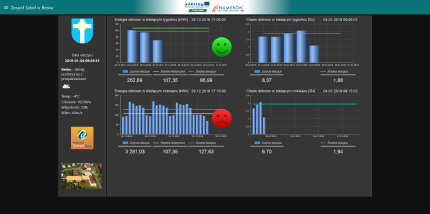
The Polish pilot engages 9 public buildings from 3 AP municipalities (3 administration buildings, 4 educational buildings and 2 service buildings) in energy saving activities integrating analytical and behavioural approach to reducing energy consumption & related costs. Analytical measures include installation of smart metering systems with dedicated software enabling better energy management, setting up alarms, etc., while behavioural ones include encouraging change of building exploitation and maintenance routines, as well as change of user behavior based on better awareness of the building, energy and energy saving methods. In order to create sense of rivalry and strive for the highest possible savings a competition for the "energy-saving master" was organised with the building teams being rated both for level of savings achieved and for completing relevant tasks on the path leading towards them (with some extra points to be obtained for special creativity and finding "untypical" ways for energy saving). 6 tasks were prepare and given to the building team and PNEC’s staff helped with the execution of some of them on the spot. The tasks prepared are: (1) internal energy review/audit of the building; (2) social audit of the building; (3) exploring and using heat saving potential; (4) exploring and using electricity saving potential assoc. with lighting; (5) exploring and using electricity saving potential assoc. with electric appliances. Each task was accompanied by a task report to be filled in by the building teams. In between the tasks the building teams received short thematic newsletters with further food for thoughts and energy-saving tips. Installed smart metering systems are very important element of the pilot action, as they not only enable real-time monitoring of electricity & heat consumption and seeking possible optimizations, but also give immediate feedback on the results of implemented measures. They have been described in detail in the Investment Factsheet delivered with the previous report. Since the systems have been installed and launched into operation in more or less parallel time than start of the competition, historic data from energy bills and meters will be used to calculate achieved annual savings. These data have been already collected and analysed by PNEC. Once energy savings are calculated for each building and collected points summarized, the “energy-saving master” will be announced during official award ceremony planned in Spring 2019. The experience is also being used for delivering "Reinvestment action plan" (for reinvesting financial savings achieved in further EE measures) and an "Action plan for energy efficiency in public buildings" (aimed at introducing tested and other project tools in a wider range of buildings).
PP7 - Hegyvidék (Municipality of 12th District of Budapest)
Again energy vampires!

Before designing and introducing DSM tools in the 9 pilot buildings of Hegyvidék, the external experts - engineers from the Technical University of Budapest - visited all the pilot buildings conducting interviews with building managers and users and checked the technical condition of the buildings from energy efficiency point of view. Based on the experiences of these visits, the experts prepared a suggestion list for the pilot buildings including recommendations for the technical improvement and energy efficient usage of the buildings as well as for the application of DSM tools. As the first step of the pilot, some pilot building users were invited to work voluntary in designing and implementing pilot actions. Their task was to observe the building users’ behaviour and detect anti-energy efficient habits. Meetings were regularly organised for the voluntaries which were called energy commando meetings led by the external experts and the project team of the municipality including trainings how to extract data from the smart meter system and understand the graphs presented on the dashboards. Energy efficiency competition was organized between the pilot buildings with the participation of the energy commandoes. In addition, energy days were organized with the Humphry character (puppet show and workshop) in 4 pilot kindergartens during Autumn 2018. Also, the Humphrey drawing book, as DMS tool, was applied in the kindergarten pilot buildings. The key success of this tool is rooted in the fact that both parents and children learn about energy efficient behaviour colouring the drawing book as while children are colouring, parents are explaining them the texts. Furthermore, Humphry crochet were produced by voluntaries which will also be used among children in the pilot kindergartens. Moreover, Humphrey puppets, posters and stickers will be distributed in the kindergartens. Beside DSM tools, parents were addressed by a short guiding document which explains the meaning of the measured smart meter data placed next to the dashboard in the kindergartens (see picture in Annex). In the Budai Drawing School pilot building, a local workshop was organized in the frame of a one week long open event where students of the drawing school designed sticker and poster graphics. Each graphic was designed for raising awareness and attention of building users for energy efficiency and other environmental issues. The best graphics were printed out and will be placed in the pilot buildings (Kis János atb, Börszörményi Office, Municipality Office Building) addressing behavioral change at building users. For instance, posters will be placed on the corridors, stickers above the light switchers. In order to raise the building users’ attention for the posters, stickers and present the results of the measurements made by the smart meters, a one-day long game will be organized in each office building. In the MOM Cultural and Sport Centers an adult colouring canvas was created, and a drawing exercise was organized for the building users in December 2018. While people colored the picture, they discussed energy efficiency issues and the smart meter data measured which is partly the result of their building usage behavior. In the Mom Cultural Centre, also the tutorial video produced by Hegyvidék was displayed continuously in the main hall where visitors could watch it.
Hegyvidek (Budapest) Interview with a project stakeholder
PP8 - SIEA Slovak Innovation Energy Agency
Daily Energy Efficiency Minimum Committment Slovakia !
How to transform a practice in a good habit or… to break bad habits!
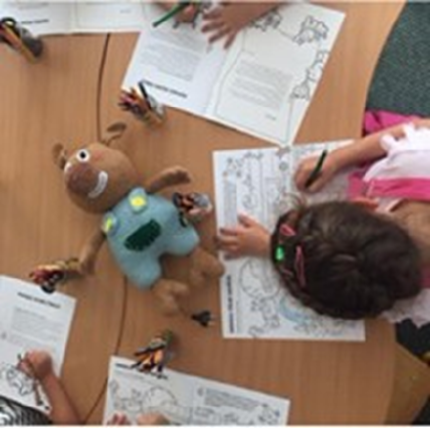
Pilot actions were conducted in six public pilot buildings, each with its specific needs and implementation possibilities.
1.2 elementary schools – Výčapy Opatovce, Rišňovce (school with kindergarten)
2.1 Kindergarten – Veľké Kostoľany
3.3 Institutional buildings – Rišňovcce, Výčapy Opatovce, Veľké Kostoľany
At the beginning of each pilot action we focused on introduction of TOGETHER and its aims and benefits. The main activity of the project was the implementation of behavioural interventions and the raise of energy effectiveness knowledge. The educational value was the most important since the largest number of participants were students and teachers. We used tools and language appropriate for group of attendants the pilot action was dedicated for. We can divide audience into two main groups according to the audience´s age.
1. Group consisting primary of students and kids (age range 4-15 years)
2. Adults working in public buildings by themselves (administrative and office clerks, local managers, engineers,) or with students (teachers).
We have paid a large amount of attention to understand special needs of specific groups and find the right approach for them to profit as much as possible from provided materials, activities, workshops and discussions. The first group, students and kids from kindergartens were really an interested, listening and reacting audience since learning by doing, by following examples and executing tasks was very interesting for them. We have built a strong base of activities we executed on the given premises and offered many following activities they were participating at when workshops were over. Naming just few we used (activities are explained in more detail in Pilot Actions Report):
- Energy Quiz about basic knowledge of energy and its usage
- Stickers distribution around the building and public space
- Daily Energy Efficiency Minimum Commitment
- Water and electricity Experiments
- Creativity workshop
- Activities with Handbook, educational video and others.
According to the given feedback, the interest was increased even after pilot activities workshops were over because we have made them to make commitments to follow specific actions and procedures. We have introduced many activities and we are now able to examine which were met with a great success and which were of a smaller one. The biggest success were activities were student’s involvement was needed such as experiments with water, electricity where student’s participation was needed. In kindergartens and lower grade classes there were the activities combined with the Handbook Energacik and experiments that had the biggest response. Adult audience was of a great challenge. Influence someone who does not have a direct financial impact on the costs is quite difficult. We are happy to have had the opportunity to conduct workshops and activities to the audience that was interested and even though their capacities were limited, they dedicated themselves deeply into activities and discussions. We have introduced the topic with a presentation followed by a quiz, had interesting discussions about daily life and building users’ needs and habits. We have closed our workshops with a questionnaire to be able to get a real feedback from participants.
- Daily Energy Efficiency Minimum Commitment: as with students we have introduced this commitment to adults and gave the opportunity to create their own list of rules to follow.
- Distribution of supporting materials such as TIPS, Handbook for children, stickers: we have printed out many copies of different TIPS that were distributed in the area of public buildings, posted to the Bulletin board where other building users can read and get information. Education materials were sent to mayors and they have distributed them via email to citizens in information campaign. Videos were distributed as well and some premises even uploaded them to their webpages.
Last but not least, pilot actions have covered not only of educational activities, but also energy management activities. Some time after the installation of smart metering system, SIEA had started with analysis of gathered data. The findings from this data, are frequently discussed with mayors and building managers in order to improve energy efficiency. We are at the begging of this process but it is already possible to see some results. Our team analyses the data on monthly basis, searching for anomalies. So far it was possible to find 3 consumption jumps (vastly increased consumption in one day) which are currently under investigation of mayors. Regarding the better management, it appears that manager of the Kindergarten, heats the building every Sunday (before week starts on Monday) unnecessarily much, resulting in very low consumption in upcoming days. Such data analysis and consulting the results with mayors and managers is only it at the beginning (due to the delay in installation), however SIEA plans to continue with the analysis and consultations at least until the end of the project in May.
PP09 - Municipality of Paks
3D Modelling combined with BIM for pilot buildings!
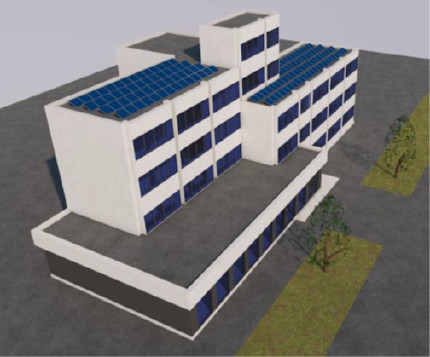
The pilot action is composed of two main parts:
1. Defining the energy performance and lavish points, leakages, malfunctions and wrongly planned or operated parts of the pilot buildings;
2. Designing and launching actions to make up these problems and reduce energy consumption also in general by eco-conscious behavior.
Both the first part and the second part consisted two different actions. To define the energy characteristics of the involved buildings, their energy flows had to be measured and compared in time and with other similar buildings. For this measurement the smart metering system was installed with an Energy Management Software. This investment was completed in all 11 pilot buildings of Paks in Sept 2017. Data is collected different ways depending on the energy source. In case of electricity, control meters have been installed right next to the billing meters, which are owned by the DSO an used for the official measurement of the consumption and issue the invoices in this basis. The control meters are smart meters with data transmission functions, they send the data to the server where the EMS software is running. The EMS analyses the consumption and creates reports upon requests. The consumption values and the consumption curves can be checked online and they are also projected by dashboards on the tablets installed at the 11 pilot buildings of the municipality. Gas is measured in slightly different way, as the gas meters were already available to transmit the signals, but the data was only collected by the DSO. In the frame of TOGETHER Paks has equipped these meters with wireless transmitters, which forward the consumption data to the server and the process from this point is the same as described at the electricity meters. Heat consumption is also measured at 4 buildings out of the 11 pilot sites. Heat consumption meters with wireless transmitters have been installed and providing consumption data for the server. Examples for the hardware used: district heating: Kamstrup 602, Kamstrup MC403; gas: MC602 transmitter + antenna added to existing DSO meter; electricity: ITRON ACE6000, Landis+Gyr E550, ACTARIS C114UR1D, ACTARIS SL7000, ITRON ACE3000, MC602 transmitters, OMNIPOWER 100/5 + antenna. The software was developed for energy management directly for the Municipality of Paks, already before the TOGETHER project. It was measuring the consumption of some public buildings, which are not involved into TOGETHER. The new meters of the current project have been integrated into this EMS, which is based on SAIA WEB system. The software measures heat consumption, gas consumption, electricity consumption and also water. It creates reports for periods defined by the users and also analyses the consumption in order to provide the possibility to decide what electric capacity and gas capacity is necessary at the measured buildings. Data is transmitted by wireless transmitters. Optical data reading is also possible.Dashboards are located in each measured buildings, usually at the entrance in order to reach the maximum possible number of persons in the building. The dashboards show the current consumption measured by the meters of the buildings (It differs from building to building: electricity is measured in all buildings, but at some buildings gas or heat consumption is also measured.). Curves of different time periods can be also visualized. The dashboards are not interactive. Once the baseline consumption data was available, we had to define where are the lavish usage points and inefficient parts of the buildings. Therefore official energy certifications have been conducted at each pilot buildings, defining the current energy category of the building, the suggested interventions (such as insulation of the building, installing solar panels on the roof) and the achievable energy category of the building. To analyse the suggested refurbishment activities’ feasibility, 3D modelling was used with a special software (ArchiCAD). The investment needs were visualized this way for the decision makers. The identification of the necessary investments – that will be able to gain the highest cuts on energy consumption – have been followed by the demand side management actions. These actions compose the essence of the project: to show people that investments are not enough (and sometimes not possible due to financial or legal reasons) to reduce energy consumption, the participation of all building users are inevitably important and required. Therefore Municipaity of Paks organized bilateral discussions with the building managers, printed 2800 stickers for switches and taps, 60 posters in 3 versions for awareness raising, 5000 pieces of A5 leaflets with energy saving possibilities for building users, and several A3 posters that describe the functioning of smart metering and energy management. Besides, company newsletters were planned and the project’s findings have been integrated into the education of the Energetic Secondary School. The measurement of the results of these activities are ongoing, and will be used in the documents of WP T4 of the project, especially at the D.T4.3.2 Local reinvestment plans connected to pilot buildings, that will provide guidelines how to reinvest at least 20% of the savings achieved by the energy efficiency actions of the pilot buildings.